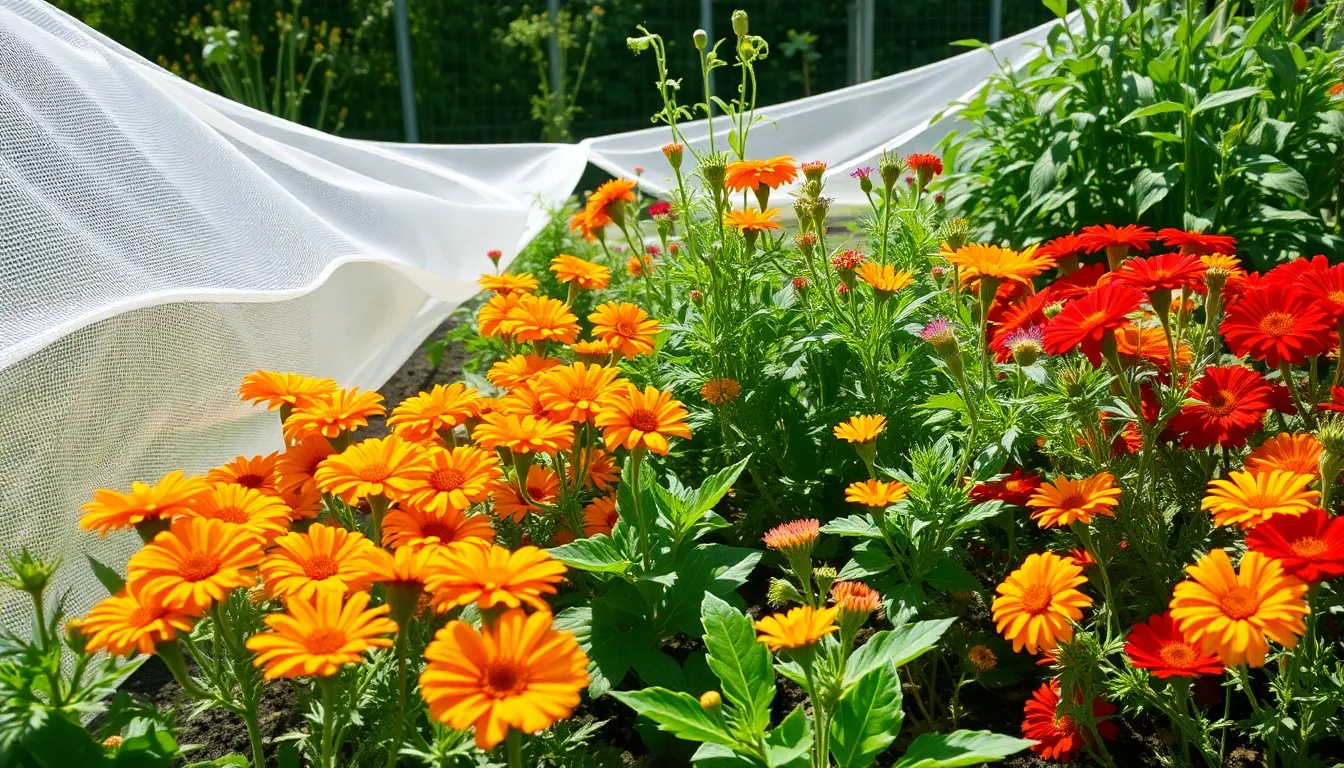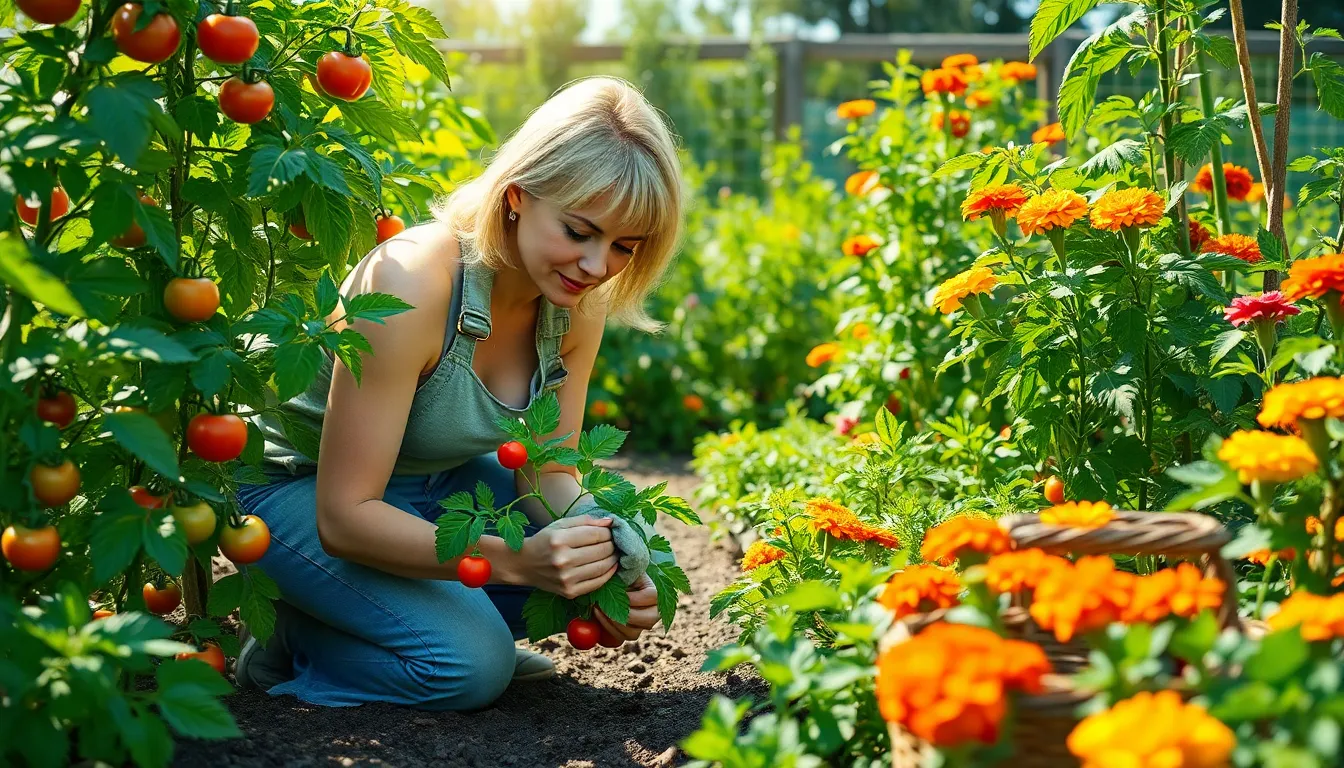Every gardener knows the struggle: one minute, you’re nurturing your plants, and the next, it feels like a buffet for pests. Those pesky intruders can turn a thriving garden into a battleground. But fear not! Keeping pests at bay doesn’t have to involve elaborate traps or a PhD in entomology.
How To Keep Pests Out Of Garden
Gardeners often encounter pests that threaten the health of their plants. Identifying these pests and understanding their behaviors proves essential for effective management.
Common Types of Garden Pests
Aphids, small sap-sucking insects, often cluster on new growth, creating weak plants. Caterpillars, in various forms, eat leaves and can decimate entire crops. Beetles, especially the Japanese variety, target roots and leaves, harming growth. Slugs and snails leave a characteristic slime trail and eat tender plant parts. Whiteflies, resembling tiny moths, hover near plants and weaken them by extracting sap. Each of these pests requires specific strategies for control and prevention.
Signs of Pest Infestation
Unexpected wilting or yellowing leaves often indicate stress from pests. Holes in leaves suggest active feeding from caterpillars or beetles. Sticky residue on plants, known as honeydew, frequently indicates aphid or whitefly presence. Visible webs may reveal spider mites, while unexplainable plant damage can hint at root-feeding pests. Frequent visits by birds or other predators may suggest that garden invaders are present. Observing these signs early allows for prompt action against infestations.
Preventive Measures

Effective pest management starts with prevention methods. Gardeners can use several strategies to keep pests at bay and protect their plants.
Choosing Pest-Resistant Plants
Selecting plants that resist common pests serves as a primary defense. Native plants often exhibit resilience to local pests. Hardy varieties are designed to thrive in specific environmental conditions, reducing attraction for pests. Additionally, incorporating companion plants can deter unwanted insects. Marigolds and nasturtiums effectively repel pests like aphids and whiteflies. Prioritizing diversity in plant selection enhances the garden’s overall health, making it less appealing to invasive species.
Creating Barriers
Constructing physical barriers acts as a strong deterrent against pests. Row covers made from lightweight fabric prevent insects from accessing plants while allowing light and moisture in. Fencing protects gardens from larger critters like deer and rabbits. Garden nets provide an effective shield against birds and insects. Copper tape can discourage slugs and snails due to its reaction with their slime. By implementing these barriers, gardeners reduce the likelihood of pest invasions significantly.
Natural Pest Control Methods
Natural pest control methods offer effective ways to protect gardens without harsh chemicals. Gardeners can explore companion planting techniques and homemade solutions to deter pests.
Companion Planting Techniques
Companion planting involves pairing plants that benefit each other. For instance, marigolds emit a scent that repels nematodes, offering protection to nearby vegetables. Similarly, basil planted next to tomatoes can keep pests like aphids and whiteflies away. Moreover, planting garlic throughout the garden can naturally deter a variety of insects. Strategically arranging combinations of plants encourages biodiversity, disrupting pest cycles effectively. Using flowering plants also attracts beneficial insects such as ladybugs and lacewings that prey on harmful pests.
Homemade Solutions
Homemade solutions provide easy alternatives to store-bought pesticides. Spraying a mixture of water and soap can suffocate soft-bodied pests like aphids. Additionally, combining garlic or chili powder with water creates a potent repellent against various insects. Neem oil, derived from the seeds of the neem tree, acts as an organic pesticide that disrupts the life cycle of many pests. Applying diatomaceous earth around plants creates a barrier; this powder scratches and dehydrates insects that come into contact with it. Regular applications of these homemade mixtures support healthy garden maintenance and pest control.
Chemical Solutions
Chemical solutions can effectively manage certain pest problems in gardens. Gardners must consider using them only when other methods haven’t worked.
Pesticides: When to Use
Pesticides come into play when pest populations exceed manageable levels. Monitoring pest numbers allows for timely interventions. It’s crucial to apply pesticides at specific growth stages of pests. Early application can prevent significant damage. Targeting the right pests ensures better efficacy. Carrying out treatments during calm weather minimizes drift and maximizes absorption.
Safe Application Practices
Safe application practices are vital in using pesticides responsibly. Always read and follow label instructions for proper usage. Wearing protective clothing safeguards against exposure. Applying pesticides in the evening reduces the risk of harming beneficial insects. It’s important to avoid windy days for optimal control and minimal drift. Ensuring sprays reach only the intended areas limits unnecessary chemical exposure. Lastly, using spot treatments instead of widespread applications helps maintain garden health.
Maintenance Tips
Maintaining a healthy garden requires consistent efforts to keep pests at bay. Regular inspections and proper watering enhance plants’ resilience against infestations.
Regular Garden Inspections
Conducting frequent garden inspections identifies early signs of pest activity. Look for wilting leaves, irregular growth patterns, and any visible pests on plants. Early detection facilitates timely intervention, minimizing potential damage. Utilize a checklist of common pests to streamline the inspection process and ensure thorough coverage. Inspect underneath leaves and at the soil line, as these areas often harbor hidden pests. Engaging in this practice fosters a proactive approach to pest management, ultimately leading to a healthier garden ecosystem.
Proper Watering Techniques
Implementing proper watering techniques significantly reduces pest attraction. Overly wet soil encourages pests like slugs and mosquitoes, while consistent watering sustains plant health. Utilize drip irrigation to target roots directly, reducing leaf moisture. Watering early in the morning prevents prolonged moisture on foliage, deterring fungi and insect infestations. Check soil moisture regularly to avoid both under-watering and over-watering. Focus on watering at the base of plants to enhance soil drainage and minimize the risk of pests thriving in damp conditions.
Conclusion
Maintaining a pest-free garden is achievable with the right strategies in place. By understanding pest behaviors and recognizing early signs of infestation, gardeners can take proactive measures to protect their plants. Choosing pest-resistant varieties and utilizing companion planting can create a natural defense against unwanted insects.
Incorporating physical barriers and natural pest control methods further enhances garden health without relying on harsh chemicals. Regular inspections and proper watering techniques play a crucial role in sustaining a thriving garden ecosystem. With these practices, gardeners can enjoy a flourishing landscape while minimizing the risk of pest invasions.

